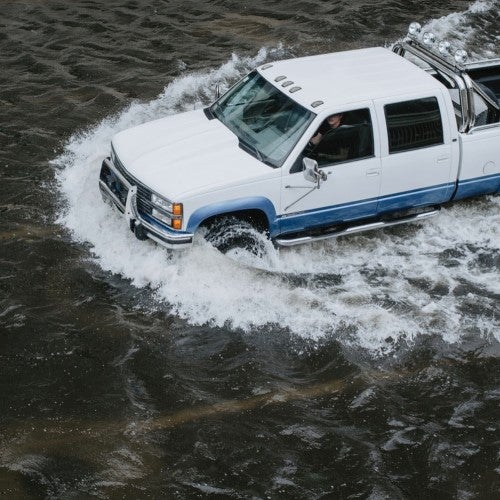Some come with warning, and some strike out of nowhere. But disasters are a fact of life, and an important consideration for all small businesses. Depending on the type and severity, being unprepared could lead to anything from lost revenue, to wiping out your business entirely.
We reached out to a few insurance professionals for advice on how to prepare and protect your small business in the case disaster should strike. Allen H. Chatterton III, President of Chatterton Insurance, Inc., and Jay D. Murphy, VP at Gallo Thomas Insurance, shared information about common disasters in Rhode Island and ways that business owners can mitigate losses, protect their assets, and get back to business as soon as possible.
Disasters in Rhode Island
While no crystal ball exists to paint a picture of what may come, Rhode Island is subject to a handful of natural disasters, as well as a few man-made ones. Our coastal exposure means that likely disasters include flooding and wind damage from hurricanes and tropical storms. The Ocean State is also subject to Nor’easters, snow events, and freezes that can damage property, cause business closure, and expose owners to legal liability for slips and falls.
While likelihood is lower, RI is not immune from other natural disasters, including earthquakes, wildfires and droughts. In addition to natural disasters, any business is susceptible to events including fires, frozen pipes, ice dams, and gas and power outages due to weather or other precipitating factors.
And while unlikely in any given year, the threat of a 100-year storm on par with–or worse than–the Hurricane of 1938 exists. Experts predict that the surge from a 100-year storm could drive two to three times farther inland than that of Superstorm Sandy, reaching Route 1A in Westerly and overall leaving almost one-sixth of the Ocean State under water. And while the definition of a “100-year storm” is that it has about a 1% chance of hitting in any given year, those chances are increasing with sea level rise and ocean warming already taking place.
“As an insurance guy,” Chatterton reports, “I often tell people I’m Chicken Little, [reminding everyone] the sky is falling. It’s to prepare people for the worst.” He hopes that being prepared will help his clients recover, should the worst come to pass.
Three critical strategies to prepare your small business for disaster
1. Be prepared.
Like a Boy Scout, have supplies and plans in place far in advance of disaster striking. While you can’t stop winds or floodwaters, you can significantly affect the level of damage your business sustains. Keep pre-cut plywood and sandbags on hand, and don’t wait until the last minute to purchase needed supplies in the event they are in limited supply. Have an emergency kit onsite with flashlights, batteries, first aid supplies, and water and food. Food businesses should have a backup generator to prevent food spoilage during power outages. Prevent pipes from freezing by keeping your heat on (even if you just turn it down) if your business needs to close in winter, and make sure you don’t run out of oil during the coldest months.
Murphy suggests having an emergency plan in place for steps to take immediately after a disaster strikes (such as turning off the gas line following an earthquake) and for communicating with employees and customers during and after disasters.
Chatterton reminds business owners to avoid legal liabilities, as well, by maintaining a safe environment. Shovel or de-ice sidewalks, store entrances, and parking lots. “Legal liabilities can be even greater than property losses, and many will sue at the slightest cause” he states.
2. Check your insurance policy.
Insurance policies widely vary, and in the case of a disaster–natural or otherwise–there is a lot of fine print that will come into play. Disasters set off chain reactions that introduce a number of conditions that may affect a small business. Read your policy carefully and contact your insurance company if needed, to confirm that you understand what is covered–and what is not.
Conditions to check include whether you have coverage for:
- damaged property (buildings) and contents (items inside your office or facility that are not part of the building).
- business income, to replace lost revenue while your business is unable to operate. It’s also important to check whether there is a waiting period (minimum number of hours your business was interrupted) that is required for a valid claim.
- extra expenses. Typically part of business income insurance, Murphy explains this would cover, say, renting a new warehouse or office space while your original site is repaired.
- food spoilage, for restaurants and markets.
- liability, for damage caused by your product or an accident that happens on your premises.
Both Chatterton and Murphy emphasized that flood insurance is separate coverage from business packages and business owner policies. If your business is in a flood zone, then you will need to purchase coverage from FEMA, or a small handful of additional private companies beginning to offer competitive policies. Otherwise, you will not be covered for property damage or business interruption arising from flooding.
Chatterton also recommends checking whether there is a clause or condition on coverage depending on the location of the disaster. Some insurance policies will only cover events that happen on the premises. Despite suffering losses, many businesses affected by the January 2019 gas outage in Newport were not covered for business interruption because the event did not happen on their property.
Two additional policies recommended by Murphy would cover events that could be disastrous for your business in other ways. The first, EPLI, or employment practices liability insurance, covers lawsuits alleging wrongful termination. The second, cyber coverage, would cover some of the losses associated with a hardware or software failure or data breach. Reminds Murphy, “It happens to small businesses, too.”
3. Be aware.
While many disasters give no warning, there’s no excuse for being unprepared for the ones that do. “Back in 1938,” Chatterton said, “they knew there was a heck of a storm in Virginia but they didn’t know what was headed their way. Now we usually get a five-day warning, or at least 48 hours.”
Information about impending hurricanes, snowstorms, and sub-freezing temperatures is readily available. Beyond watching the nightly news, sign up for email and text alerts from weather forecasters and local and regional authorities. If you don’t have supplies on hand, stock up well in advance of the last minute.
Risk reduction and resilience: How you can help
Statistics show that 40% of small businesses affected by disaster never reopen, and that 25% of those who reopen fail. Don’t become one of these statistics.
The state of Rhode Island is working to develop tools to help Ocean State small businesses mitigate losses from extreme weather events. The Small Business Resilience Project is seeking input from businesses around the state with fewer than 50 employees, to provide feedback on support materials. Participating businesses can even receive assessment and support addressing specific vulnerabilities.
At the heart of many communities, and as the source of support for so many families, small businesses are uniquely vulnerable in the face of disaster. By taking the steps outlined above, businesses will be as ready as possible to “weather the weather” and get back to business, if and when disaster strikes. Join us in preparing!




